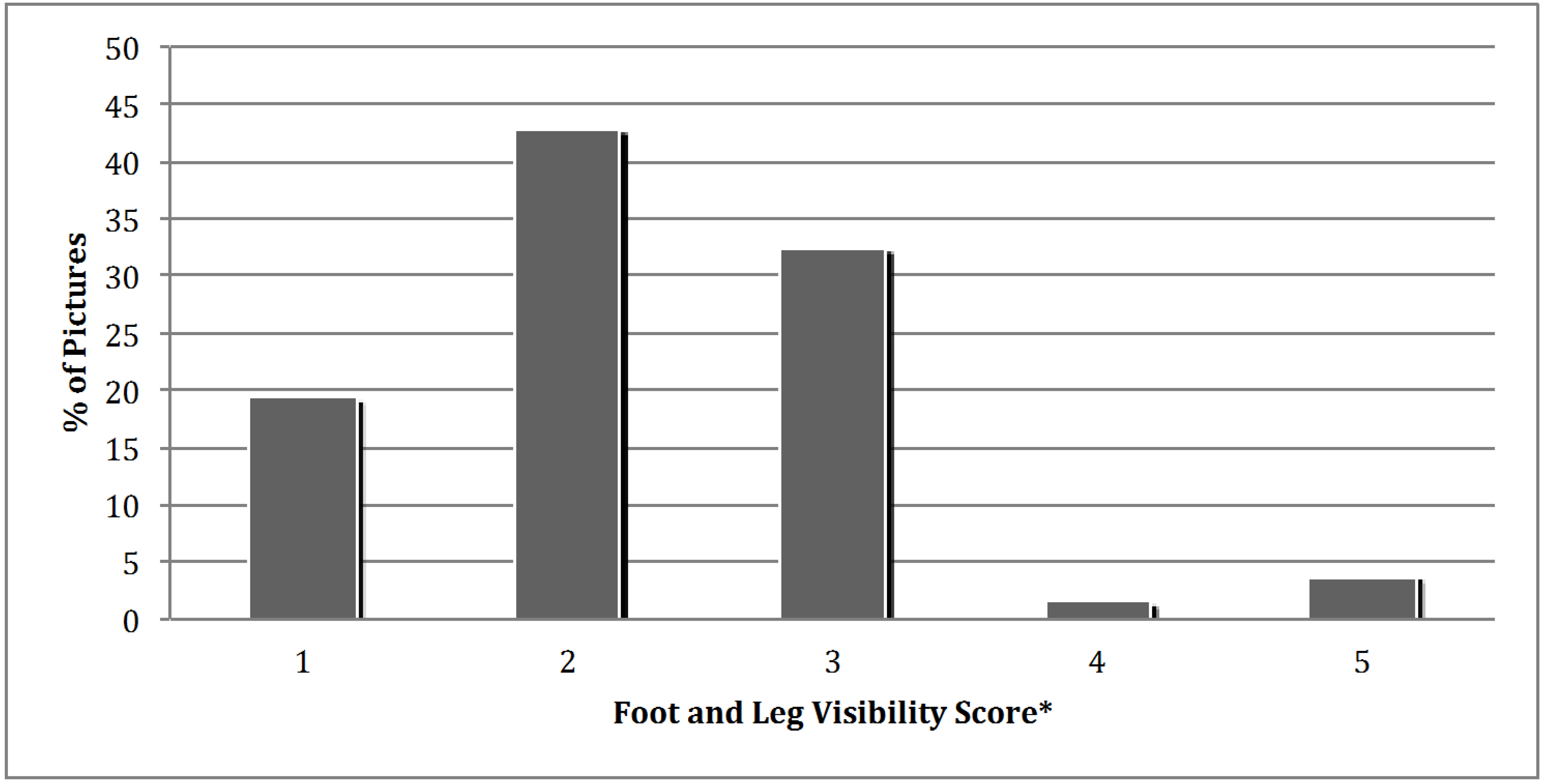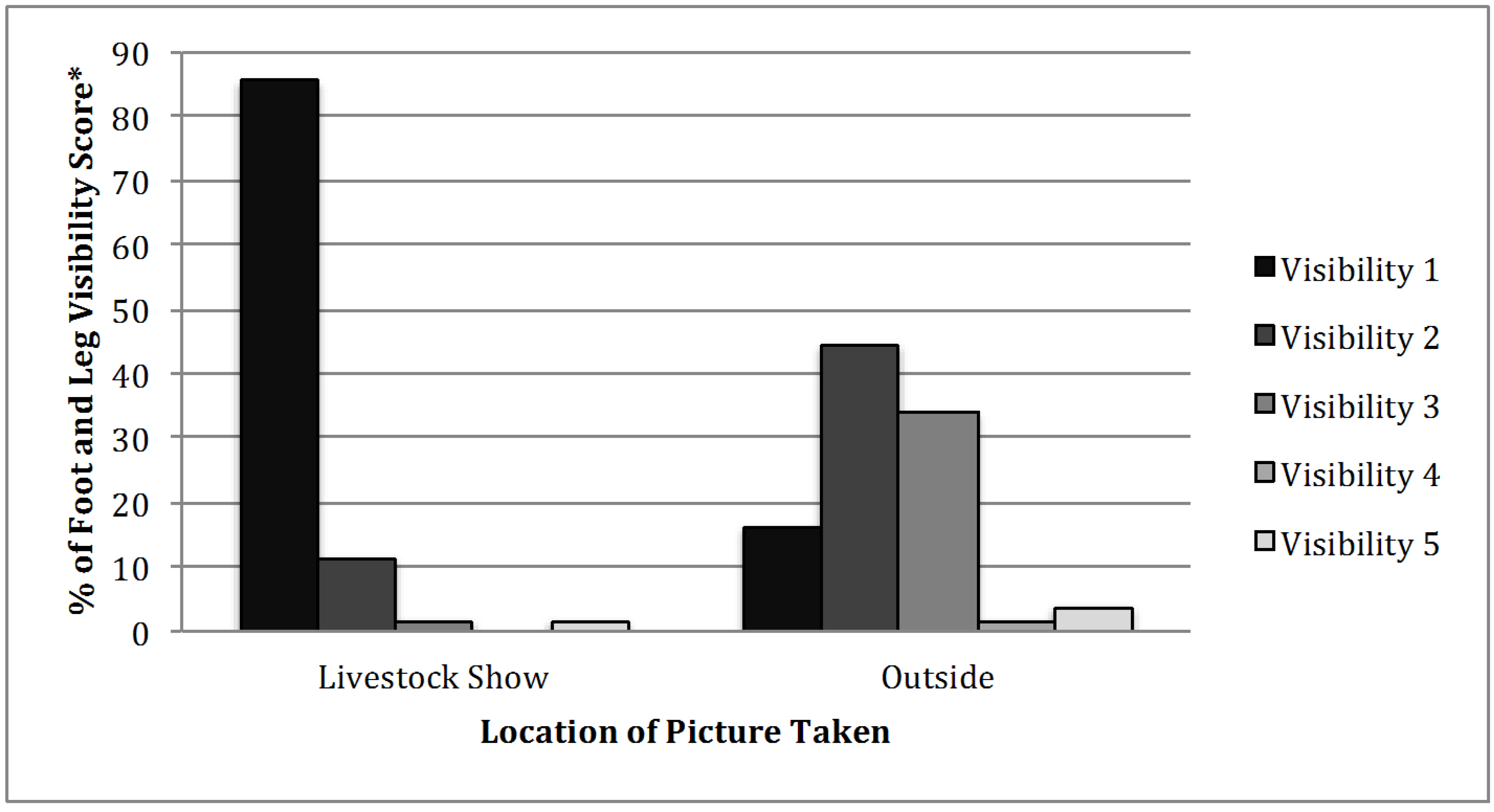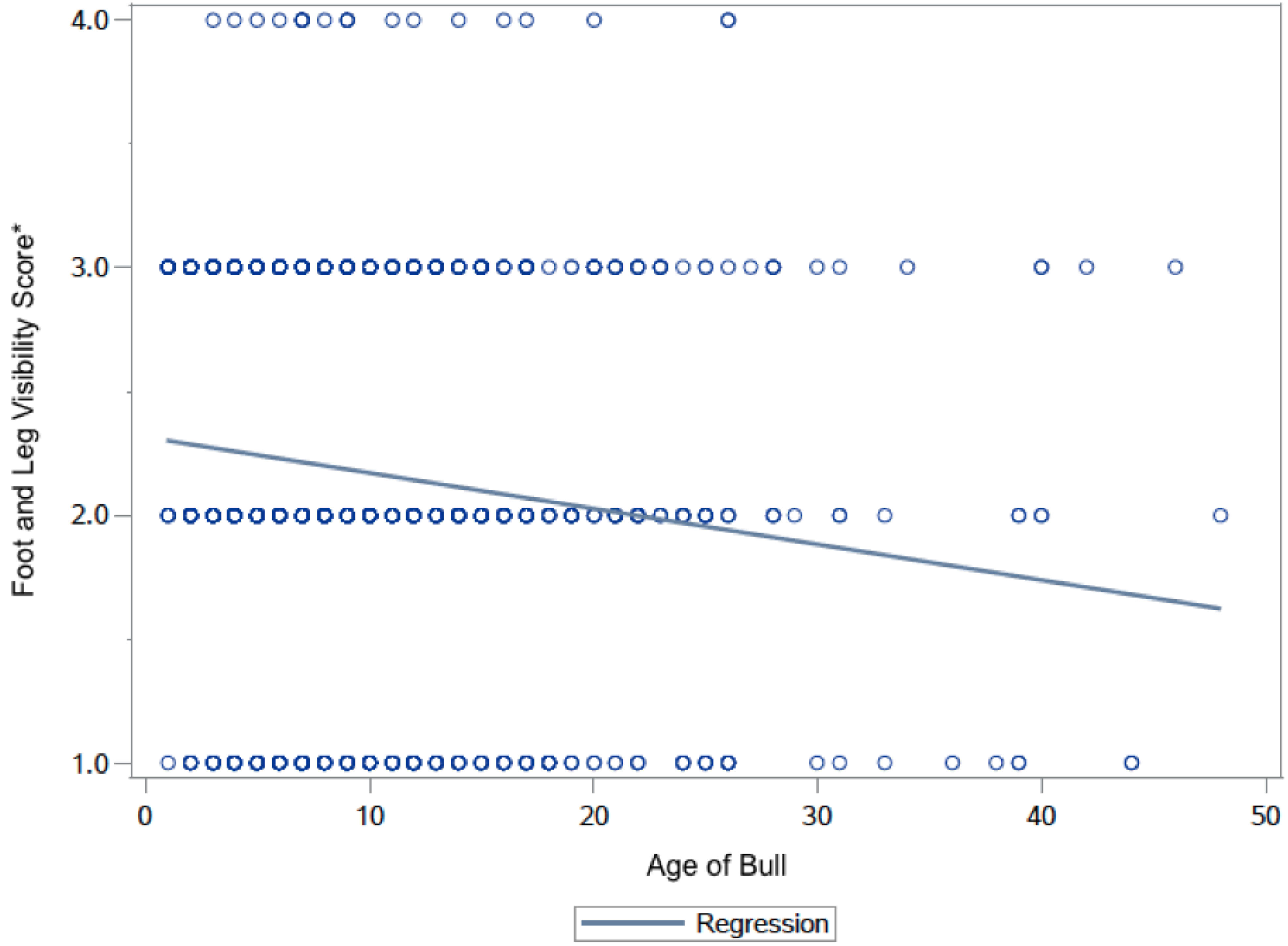A High Percentage of Beef Bull Pictures in Semen Catalogues Have Feet and Lower Legs that Are Not Visible
Abstract
:Simple Summary
Abstract
1. Introduction
2. Experimental Section
2.1. Sample
2.2. Foot and Leg Visibility Scoring Method
| Score | Description |
|---|---|
| Score 1 Score 2 Score 3 Score 4 Score 5 | Legs, hooves, and dewclaws fully visible All four hooves obscured All four hooves and dewclaws obscured All four lower legs (up to the brisket), dewclaws, and hooves obscured Either front or rear feet or legs obscured |
2.3. Data Collected on Each Bull
2.4. Statistical Analysis
3. Results and Discussion
3.1. Foot and Leg Visibility Score

3.2. Data Collected on Each Bull
| Variable | No. of Pictures | P-Value |
|---|---|---|
| Material obscuring foot and leg visibility Breed of cattle Coat Color Location of picture Semen company website Video of bull walking | 1112 1379 1379 1379 1379 1379 | <0.0001 0.4484 0.2519 <0.0001 0.1010 0.8129 |



4. Conclusions
Acknowledgments
Author Contributions
Conflicts of Interest
Ethical Guidelines
References
- McDaniel, B.T. Breeding programs to reduce foot and leg problems. Interbull. Bull. 1997, 15, 115–122. [Google Scholar]
- Van Amstel, S.; Shearer, J. Manual for Treatment and Control of Lameness in Cattle; Blackwell Publishing: Ames, IA, USA, 2006. [Google Scholar]
- Flowers, F.C.; Sedlbauer, M.; Carter, E.; Vonkeyserlingk, M.A.; Sanderson, D.J.; Weary, D.M. Analgesics improve the gait of lame dairy cattle. J. Dairy Sci. 2007, 91, 3010–3014. [Google Scholar] [CrossRef] [PubMed]
- Laven, R.A.; Lawrence, K.E.; Weston, J.F.; Dowson, K.R.; Stafford, K.J. Assessment of the duration of the pain response associated with lameness in dairy cows, and the influence of treatment. New Zeal. Vet. J. 2008, 56, 210–217. [Google Scholar] [CrossRef] [PubMed]
- Webster, J. Health and welfare of animals in modern husbandry systems—Dairy cattle. Practice 1986, 8, 85–89. [Google Scholar] [CrossRef]
- Van Dorp, T.E.; Boettcher, P.; Schaeffer, L.R. Genetics of locomotion. Livest. Prod. Sci. 2004, 90, 247–253. [Google Scholar] [CrossRef]
- Onyiro, O.M.; Brotherstone, S. Genetic analysis of locomotion and associated conformation traits of Holstein-Friesian dairy cows managed in different housing systems. J. Dairy Sci. 2007, 91, 322–328. [Google Scholar] [CrossRef] [PubMed]
- Boettcher, P.J.; Dekkers, J.C.M.; Warnick, L.D.; Wells, S.J. Genetic analysis of clinical lameness in dairy cattle. J. Dairy Sci. 1998, 81, 1148–1156. [Google Scholar] [CrossRef]
- Boelling, D.; Pollott, G.E. Locomotion, lameness, hoof and leg traits in cattle. II. Genetic relationships and breeding values. Livest. Prod. Sci. 1998, 54, 205–215. [Google Scholar] [CrossRef]
- Politiek, R.D.; Distl, O.; Fjeldaas, T.; Heeres, J.; McDaniel, B.T.; Nielsen, E.; Peterse, D.J.; Reurink, A.; Strandberg, P. Importance of claw quality in cattle: Review and recommendations to achieve genetic improvement. Report of the E.A.A.P. Working group on “claw quality in cattle”. Livest. Prod. Sci. 1986, 15, 133–152. [Google Scholar] [CrossRef]
- Smit, H.; Verbeek, B.; Peterse, D.J.; Jansen, J.; McDaniel, B.T.; Politiek, R.D. Genetic aspects of claw disorders, claw measurements and ‘type’ scores for feet in Friesian cattle. Livest. Prod. Sci. 1986, 15, 205–217. [Google Scholar] [CrossRef]
- Distl, O.; Koorn, D.S.; McDaniel, B.T.; Peterse, D.; Politiek, R.D.; Reurink, A. Claw traits in cattle breeding programs: Report of the E.A.A.P. working group “claw quality in cattle”. Livest. Prod. Sci. 1990, 25, 1–13. [Google Scholar] [CrossRef]
- Koenig, S.; Sharifi, A.R.; Wentrot, H.; Landmann, D.; Eise, M.; Simianer, H. Genetic parameters of claw and foot disorders estimated with logistic models. J. Dairy Sci. 2005, 88, 3316–3325. [Google Scholar] [CrossRef]
- SAS Studio 2014; SAS Institute Inc.: Cary, NC, USA, 2014.
- Higgman, J.; Juga, J.; Sillanpaa, M.J.; Thompson, R. Genetic parameters for claw health and feet and leg conformation traits in Finnish Ayrshire cows. J. Anim. Breed. Genet. 2013, 130, 89–97. [Google Scholar] [CrossRef] [PubMed]
- Shearer, J.K.; van Amstel, S.R. Lameness in Cow/Calf and Feedlot Cattle; Iowa Beef Center: Ames, IA, USA, 2014. [Google Scholar]
- Van der Waaij, E.H.; Holzhauer, M.; Ellen, E.; Kamphuis, C.; de Jong, G. Genetic parameters for claw disorders in Dutch dairy cattle and correlations with conformation traits. J. Dairy Sci. 2005, 88, 3672–3678. [Google Scholar] [CrossRef]
- Laursen, M.V.; Boelling, D.; Mark, T. Genetic parameters for claw and leg health, foot and leg conformation, and locomotion in Danish Holsteins. J. Dairy Sci. 2008, 92, 1770–1777. [Google Scholar] [CrossRef] [PubMed]
- West, A. 20 Years of Adobe Photoshop. Available online: http://www.webdesignerdepot.com/2010/02/20-years-of-adobe-photoshop/ (accessed on 5 December 2014).
© 2015 by the authors; licensee MDPI, Basel, Switzerland. This article is an open access article distributed under the terms and conditions of the Creative Commons Attribution license (http://creativecommons.org/licenses/by/4.0/).
Share and Cite
Franks, M.K.; Grandin, T. A High Percentage of Beef Bull Pictures in Semen Catalogues Have Feet and Lower Legs that Are Not Visible. Animals 2015, 5, 536-544. https://doi.org/10.3390/ani5030370
Franks MK, Grandin T. A High Percentage of Beef Bull Pictures in Semen Catalogues Have Feet and Lower Legs that Are Not Visible. Animals. 2015; 5(3):536-544. https://doi.org/10.3390/ani5030370
Chicago/Turabian StyleFranks, Marcy K., and Temple Grandin. 2015. "A High Percentage of Beef Bull Pictures in Semen Catalogues Have Feet and Lower Legs that Are Not Visible" Animals 5, no. 3: 536-544. https://doi.org/10.3390/ani5030370
APA StyleFranks, M. K., & Grandin, T. (2015). A High Percentage of Beef Bull Pictures in Semen Catalogues Have Feet and Lower Legs that Are Not Visible. Animals, 5(3), 536-544. https://doi.org/10.3390/ani5030370







